HI6026 Audit, Assurance & Compliance: CBA's ASX Governance & Risk
VerifiedAdded on 2023/06/13
|16
|2820
|296
Report
AI Summary
This report discusses risk management and the application of corporate governance tenets, focusing on ASX-listed companies. It highlights the importance of corporate governance principles and risk assessment in today's business environment. The report analyzes how the Commonwealth Bank of Australia (CBA) implements ASX's corporate governance principles, including defining board member roles, ensuring ethical behavior, protecting reporting truthfulness, ensuring transparency, protecting shareholder rights, managing risks, and providing fair wages. It also covers risk assessment procedures, nature of the business, market overview, business strategy, and risk management practices within CBA, emphasizing the importance of a robust risk management framework and double-check policies. Desklib provides access to similar solved assignments and past papers for students.
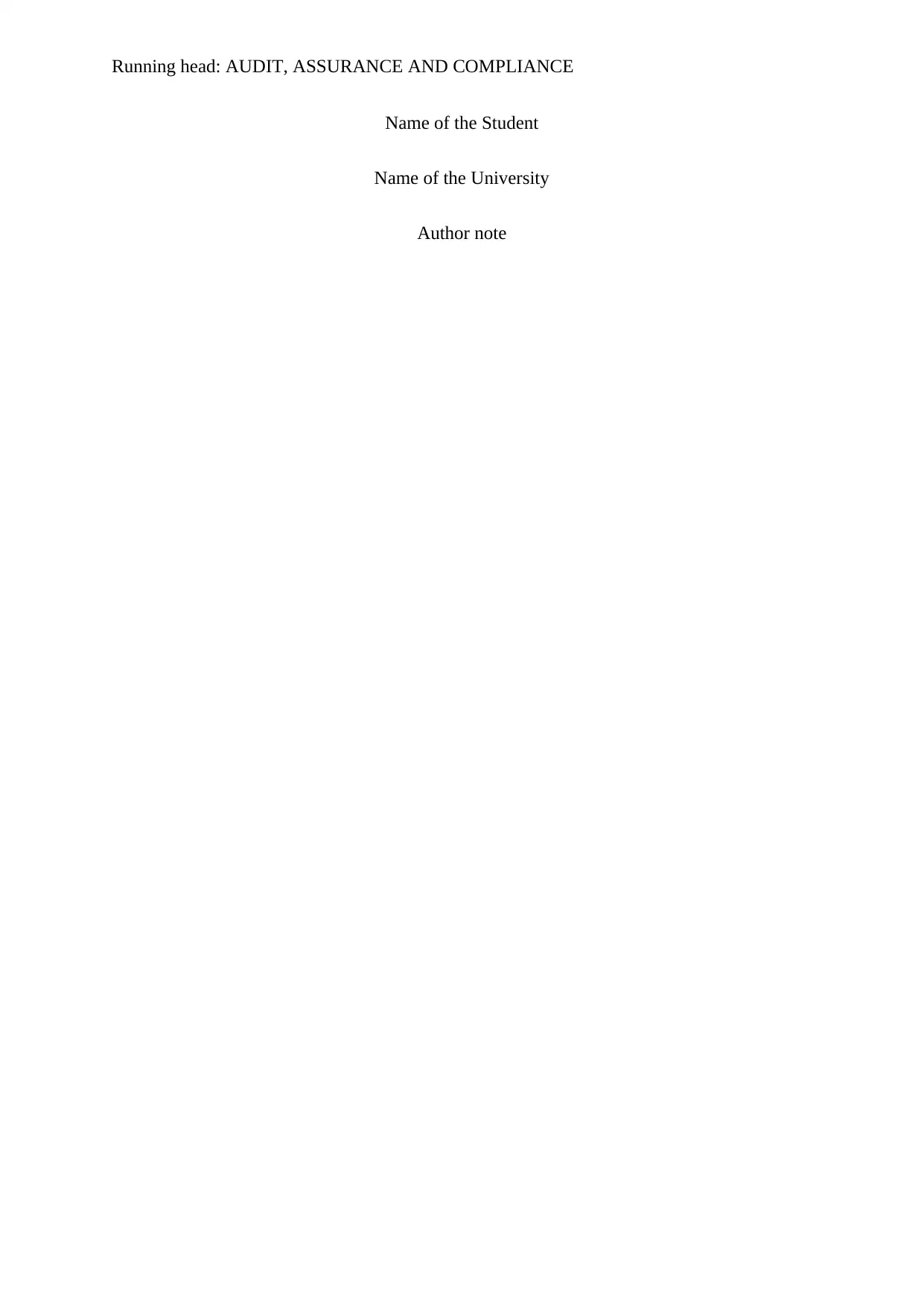
Running head: AUDIT, ASSURANCE AND COMPLIANCE
Name of the Student
Name of the University
Author note
Name of the Student
Name of the University
Author note
Paraphrase This Document
Need a fresh take? Get an instant paraphrase of this document with our AI Paraphraser
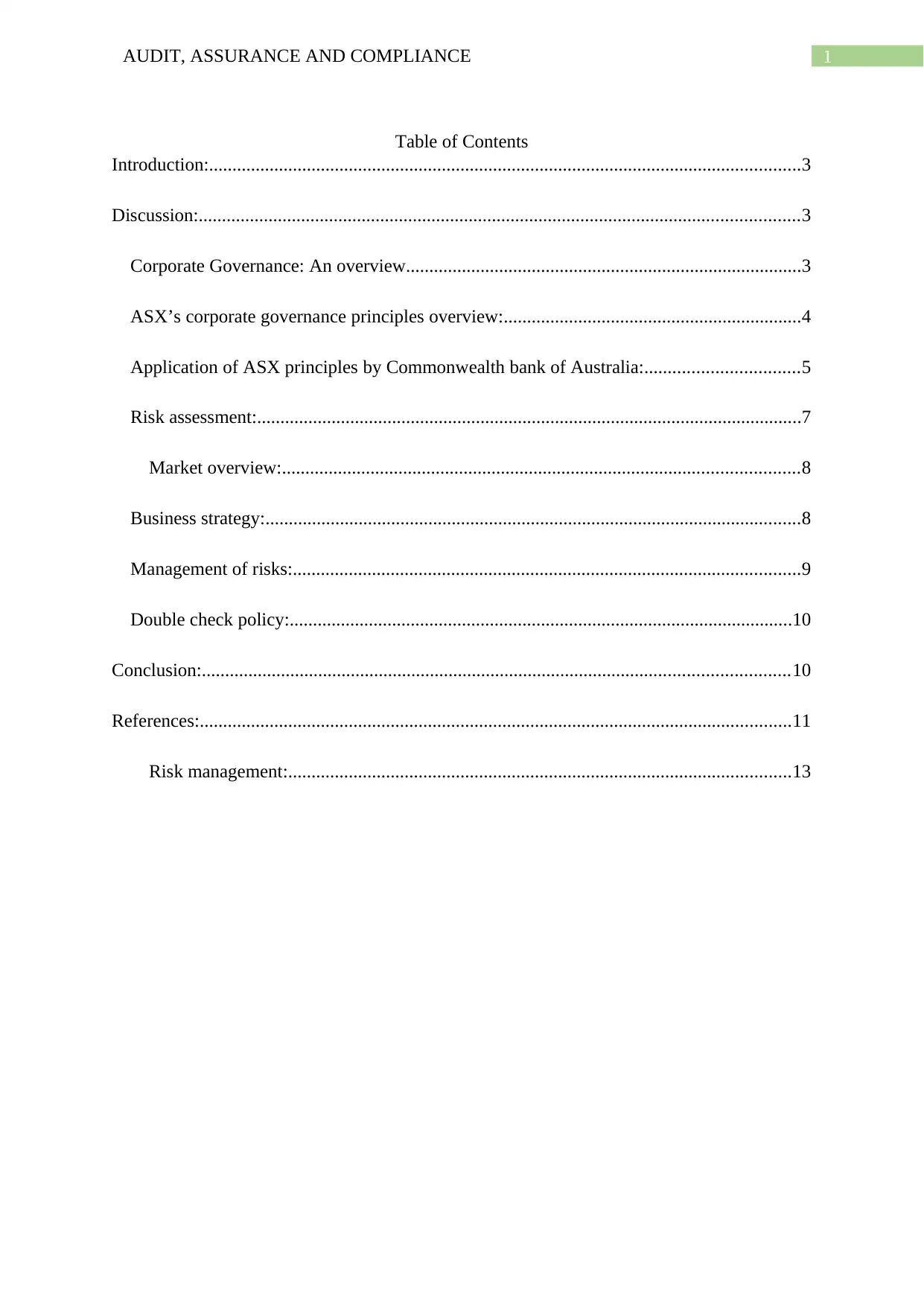
1AUDIT, ASSURANCE AND COMPLIANCE
Table of Contents
Introduction:...............................................................................................................................3
Discussion:.................................................................................................................................3
Corporate Governance: An overview.....................................................................................3
ASX’s corporate governance principles overview:................................................................4
Application of ASX principles by Commonwealth bank of Australia:.................................5
Risk assessment:.....................................................................................................................7
Market overview:...............................................................................................................8
Business strategy:...................................................................................................................8
Management of risks:.............................................................................................................9
Double check policy:............................................................................................................10
Conclusion:..............................................................................................................................10
References:...............................................................................................................................11
Risk management:............................................................................................................13
Table of Contents
Introduction:...............................................................................................................................3
Discussion:.................................................................................................................................3
Corporate Governance: An overview.....................................................................................3
ASX’s corporate governance principles overview:................................................................4
Application of ASX principles by Commonwealth bank of Australia:.................................5
Risk assessment:.....................................................................................................................7
Market overview:...............................................................................................................8
Business strategy:...................................................................................................................8
Management of risks:.............................................................................................................9
Double check policy:............................................................................................................10
Conclusion:..............................................................................................................................10
References:...............................................................................................................................11
Risk management:............................................................................................................13

2AUDIT, ASSURANCE AND COMPLIANCE
Executive Summary:
Executive Summary:
⊘ This is a preview!⊘
Do you want full access?
Subscribe today to unlock all pages.

Trusted by 1+ million students worldwide
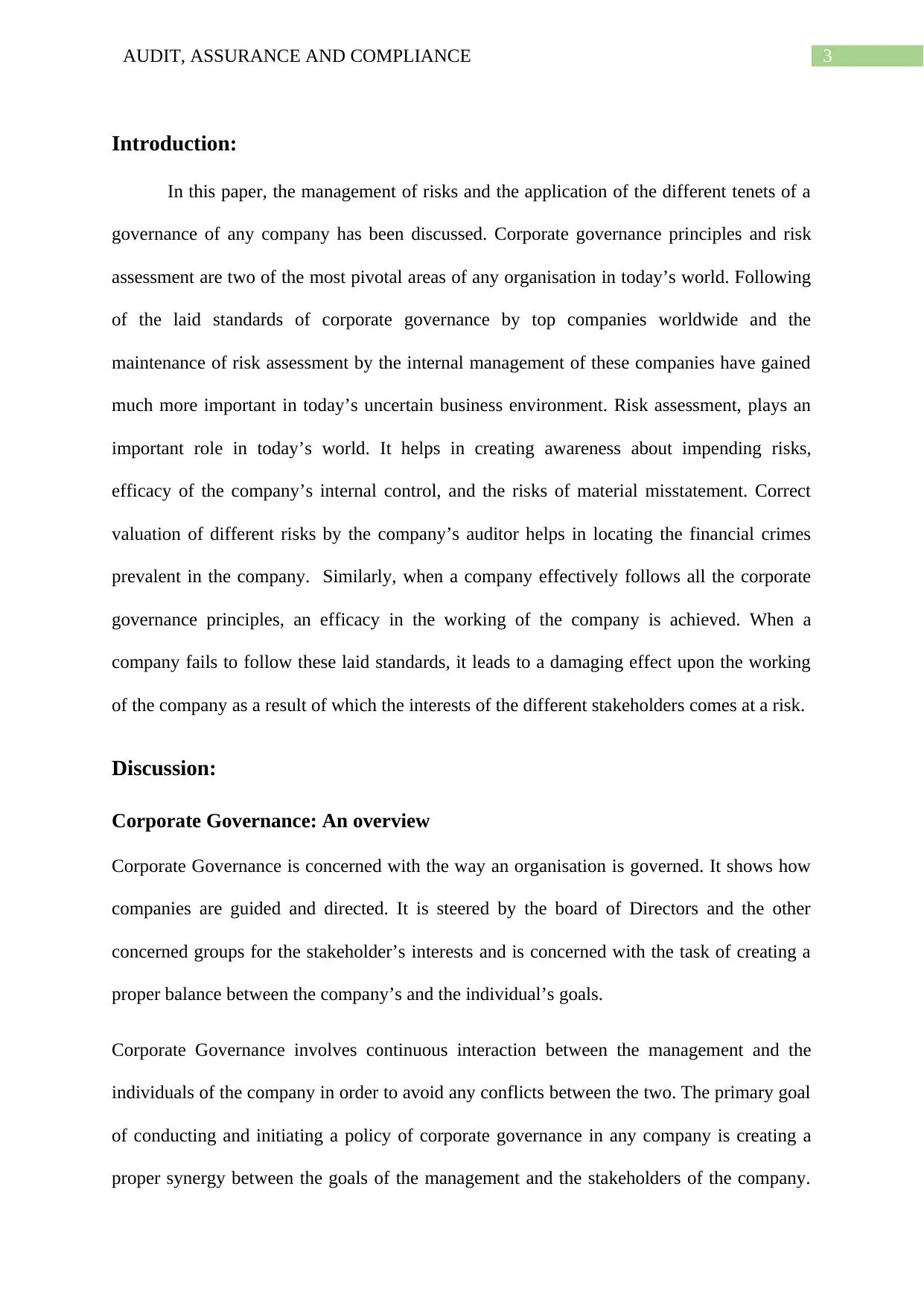
3AUDIT, ASSURANCE AND COMPLIANCE
Introduction:
In this paper, the management of risks and the application of the different tenets of a
governance of any company has been discussed. Corporate governance principles and risk
assessment are two of the most pivotal areas of any organisation in today’s world. Following
of the laid standards of corporate governance by top companies worldwide and the
maintenance of risk assessment by the internal management of these companies have gained
much more important in today’s uncertain business environment. Risk assessment, plays an
important role in today’s world. It helps in creating awareness about impending risks,
efficacy of the company’s internal control, and the risks of material misstatement. Correct
valuation of different risks by the company’s auditor helps in locating the financial crimes
prevalent in the company. Similarly, when a company effectively follows all the corporate
governance principles, an efficacy in the working of the company is achieved. When a
company fails to follow these laid standards, it leads to a damaging effect upon the working
of the company as a result of which the interests of the different stakeholders comes at a risk.
Discussion:
Corporate Governance: An overview
Corporate Governance is concerned with the way an organisation is governed. It shows how
companies are guided and directed. It is steered by the board of Directors and the other
concerned groups for the stakeholder’s interests and is concerned with the task of creating a
proper balance between the company’s and the individual’s goals.
Corporate Governance involves continuous interaction between the management and the
individuals of the company in order to avoid any conflicts between the two. The primary goal
of conducting and initiating a policy of corporate governance in any company is creating a
proper synergy between the goals of the management and the stakeholders of the company.
Introduction:
In this paper, the management of risks and the application of the different tenets of a
governance of any company has been discussed. Corporate governance principles and risk
assessment are two of the most pivotal areas of any organisation in today’s world. Following
of the laid standards of corporate governance by top companies worldwide and the
maintenance of risk assessment by the internal management of these companies have gained
much more important in today’s uncertain business environment. Risk assessment, plays an
important role in today’s world. It helps in creating awareness about impending risks,
efficacy of the company’s internal control, and the risks of material misstatement. Correct
valuation of different risks by the company’s auditor helps in locating the financial crimes
prevalent in the company. Similarly, when a company effectively follows all the corporate
governance principles, an efficacy in the working of the company is achieved. When a
company fails to follow these laid standards, it leads to a damaging effect upon the working
of the company as a result of which the interests of the different stakeholders comes at a risk.
Discussion:
Corporate Governance: An overview
Corporate Governance is concerned with the way an organisation is governed. It shows how
companies are guided and directed. It is steered by the board of Directors and the other
concerned groups for the stakeholder’s interests and is concerned with the task of creating a
proper balance between the company’s and the individual’s goals.
Corporate Governance involves continuous interaction between the management and the
individuals of the company in order to avoid any conflicts between the two. The primary goal
of conducting and initiating a policy of corporate governance in any company is creating a
proper synergy between the goals of the management and the stakeholders of the company.
Paraphrase This Document
Need a fresh take? Get an instant paraphrase of this document with our AI Paraphraser
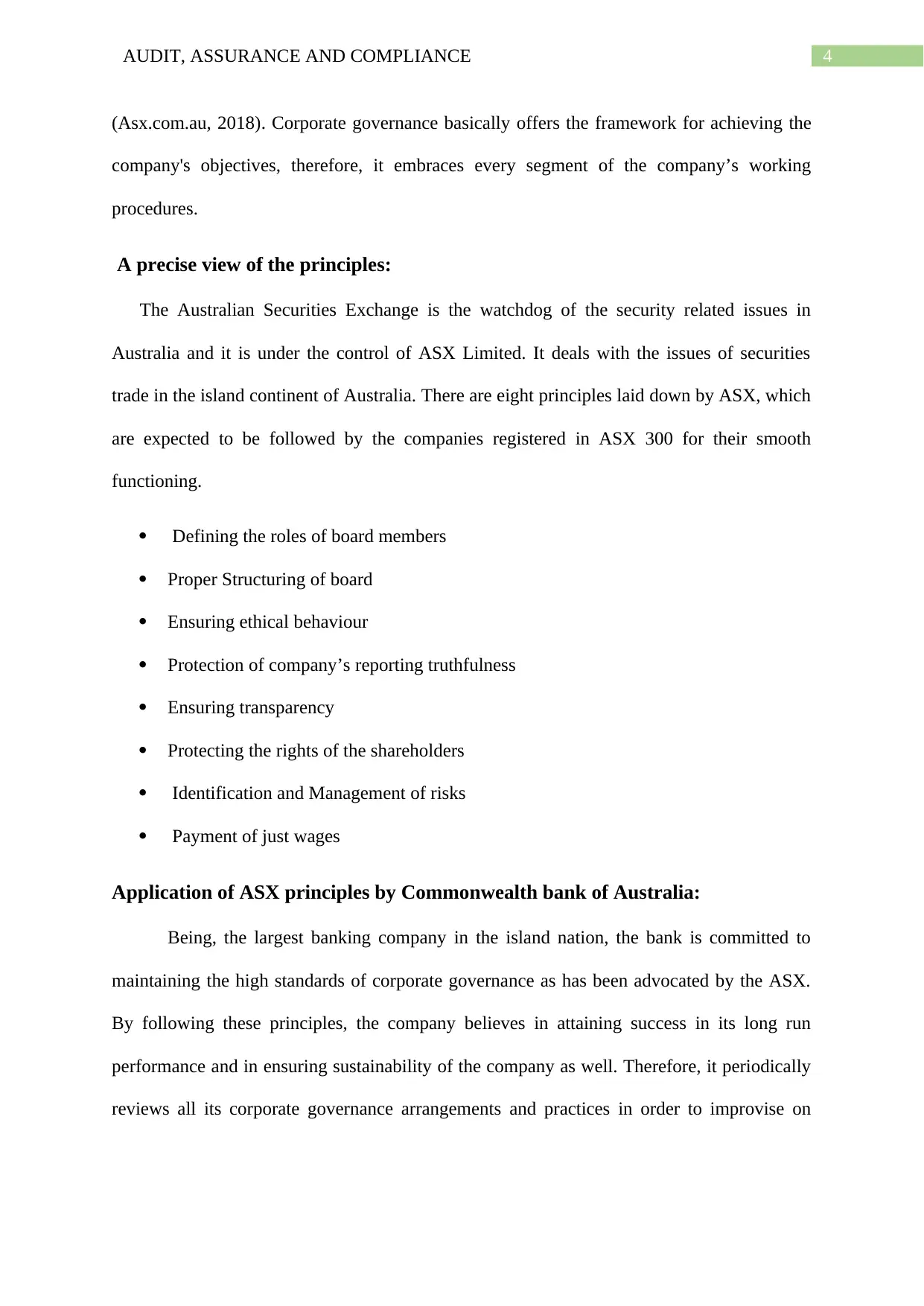
4AUDIT, ASSURANCE AND COMPLIANCE
(Asx.com.au, 2018). Corporate governance basically offers the framework for achieving the
company's objectives, therefore, it embraces every segment of the company’s working
procedures.
A precise view of the principles:
The Australian Securities Exchange is the watchdog of the security related issues in
Australia and it is under the control of ASX Limited. It deals with the issues of securities
trade in the island continent of Australia. There are eight principles laid down by ASX, which
are expected to be followed by the companies registered in ASX 300 for their smooth
functioning.
Defining the roles of board members
Proper Structuring of board
Ensuring ethical behaviour
Protection of company’s reporting truthfulness
Ensuring transparency
Protecting the rights of the shareholders
Identification and Management of risks
Payment of just wages
Application of ASX principles by Commonwealth bank of Australia:
Being, the largest banking company in the island nation, the bank is committed to
maintaining the high standards of corporate governance as has been advocated by the ASX.
By following these principles, the company believes in attaining success in its long run
performance and in ensuring sustainability of the company as well. Therefore, it periodically
reviews all its corporate governance arrangements and practices in order to improvise on
(Asx.com.au, 2018). Corporate governance basically offers the framework for achieving the
company's objectives, therefore, it embraces every segment of the company’s working
procedures.
A precise view of the principles:
The Australian Securities Exchange is the watchdog of the security related issues in
Australia and it is under the control of ASX Limited. It deals with the issues of securities
trade in the island continent of Australia. There are eight principles laid down by ASX, which
are expected to be followed by the companies registered in ASX 300 for their smooth
functioning.
Defining the roles of board members
Proper Structuring of board
Ensuring ethical behaviour
Protection of company’s reporting truthfulness
Ensuring transparency
Protecting the rights of the shareholders
Identification and Management of risks
Payment of just wages
Application of ASX principles by Commonwealth bank of Australia:
Being, the largest banking company in the island nation, the bank is committed to
maintaining the high standards of corporate governance as has been advocated by the ASX.
By following these principles, the company believes in attaining success in its long run
performance and in ensuring sustainability of the company as well. Therefore, it periodically
reviews all its corporate governance arrangements and practices in order to improvise on
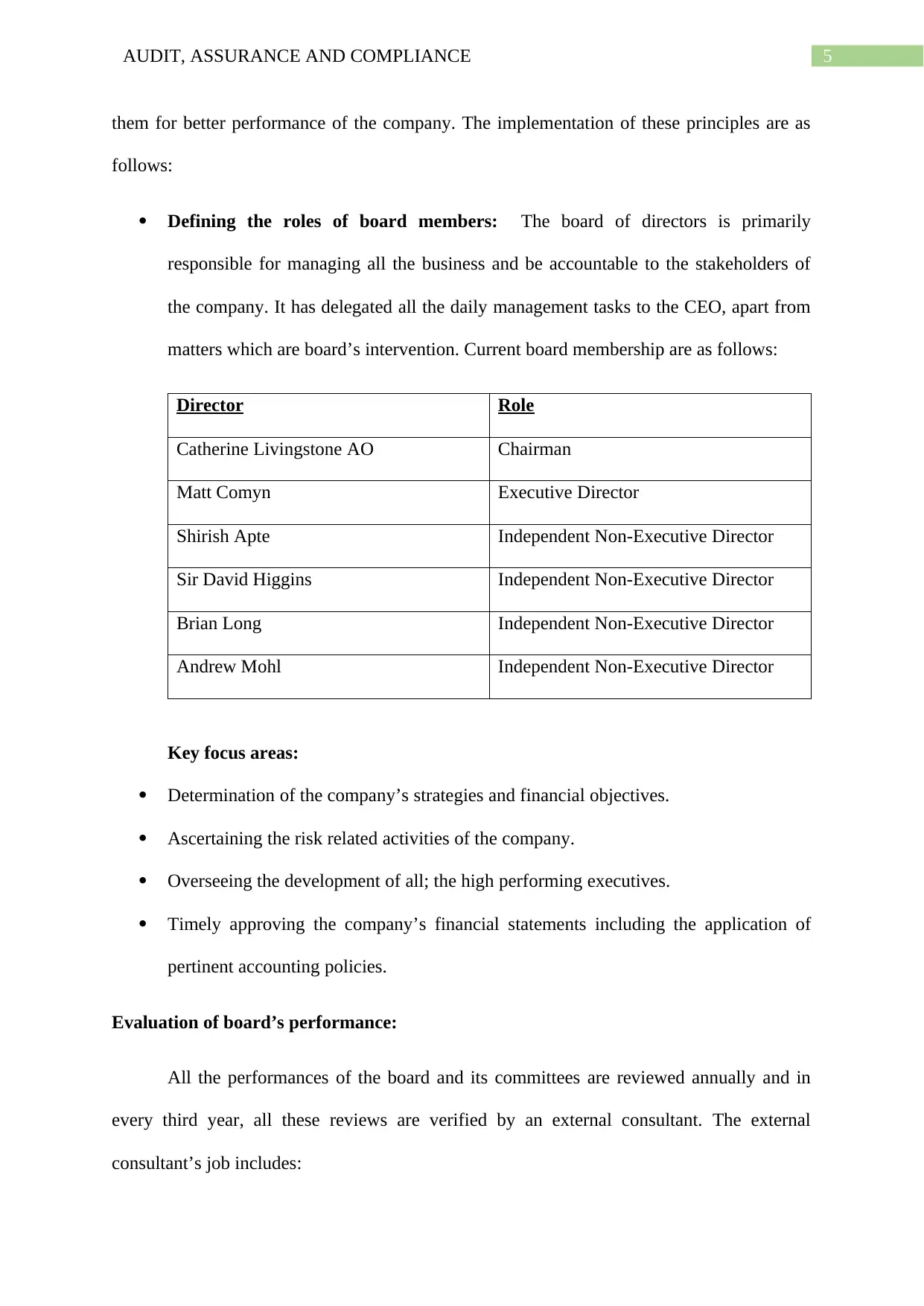
5AUDIT, ASSURANCE AND COMPLIANCE
them for better performance of the company. The implementation of these principles are as
follows:
Defining the roles of board members: The board of directors is primarily
responsible for managing all the business and be accountable to the stakeholders of
the company. It has delegated all the daily management tasks to the CEO, apart from
matters which are board’s intervention. Current board membership are as follows:
Director Role
Catherine Livingstone AO Chairman
Matt Comyn Executive Director
Shirish Apte Independent Non-Executive Director
Sir David Higgins Independent Non-Executive Director
Brian Long Independent Non-Executive Director
Andrew Mohl Independent Non-Executive Director
Key focus areas:
Determination of the company’s strategies and financial objectives.
Ascertaining the risk related activities of the company.
Overseeing the development of all; the high performing executives.
Timely approving the company’s financial statements including the application of
pertinent accounting policies.
Evaluation of board’s performance:
All the performances of the board and its committees are reviewed annually and in
every third year, all these reviews are verified by an external consultant. The external
consultant’s job includes:
them for better performance of the company. The implementation of these principles are as
follows:
Defining the roles of board members: The board of directors is primarily
responsible for managing all the business and be accountable to the stakeholders of
the company. It has delegated all the daily management tasks to the CEO, apart from
matters which are board’s intervention. Current board membership are as follows:
Director Role
Catherine Livingstone AO Chairman
Matt Comyn Executive Director
Shirish Apte Independent Non-Executive Director
Sir David Higgins Independent Non-Executive Director
Brian Long Independent Non-Executive Director
Andrew Mohl Independent Non-Executive Director
Key focus areas:
Determination of the company’s strategies and financial objectives.
Ascertaining the risk related activities of the company.
Overseeing the development of all; the high performing executives.
Timely approving the company’s financial statements including the application of
pertinent accounting policies.
Evaluation of board’s performance:
All the performances of the board and its committees are reviewed annually and in
every third year, all these reviews are verified by an external consultant. The external
consultant’s job includes:
⊘ This is a preview!⊘
Do you want full access?
Subscribe today to unlock all pages.

Trusted by 1+ million students worldwide
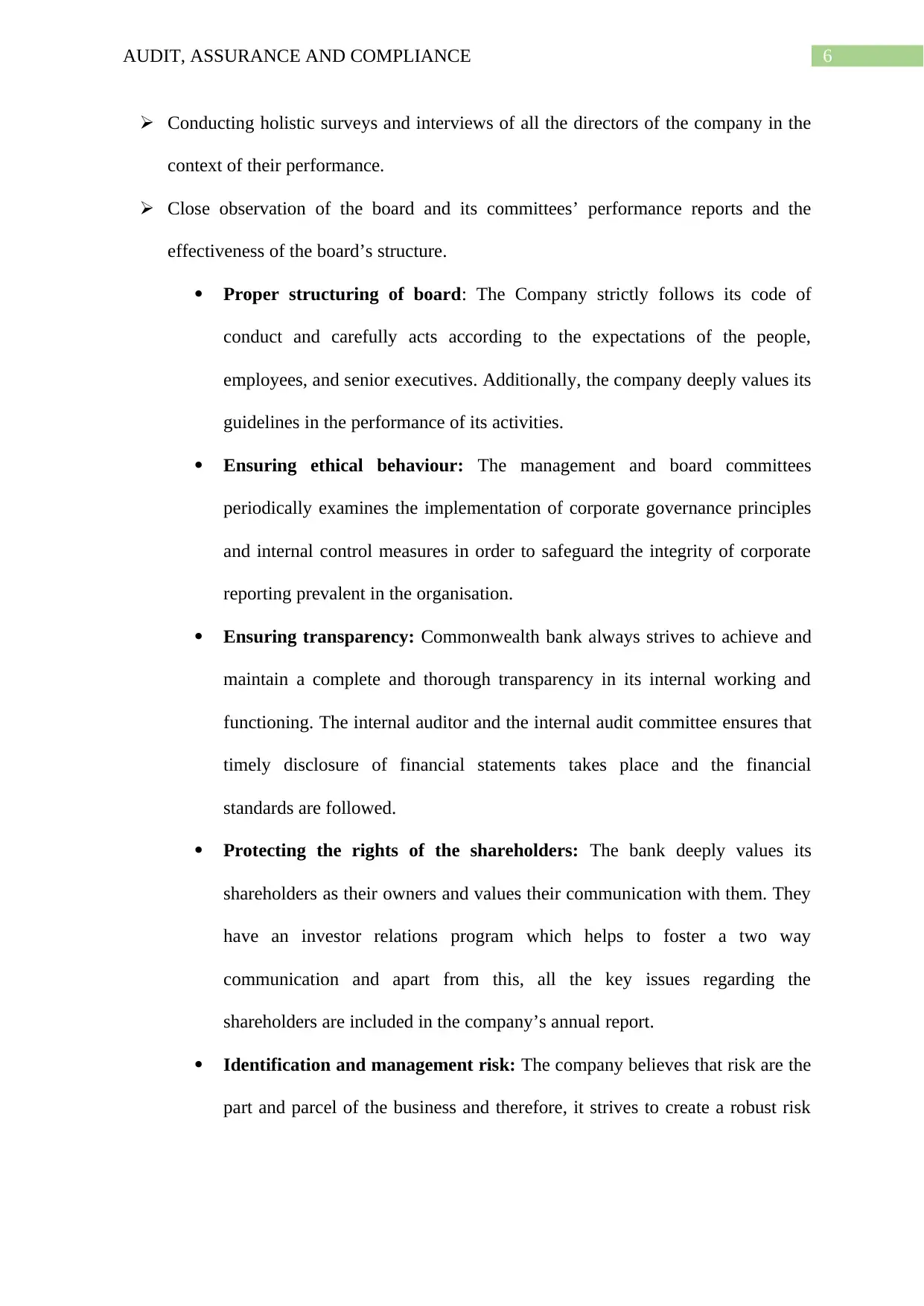
6AUDIT, ASSURANCE AND COMPLIANCE
Conducting holistic surveys and interviews of all the directors of the company in the
context of their performance.
Close observation of the board and its committees’ performance reports and the
effectiveness of the board’s structure.
Proper structuring of board: The Company strictly follows its code of
conduct and carefully acts according to the expectations of the people,
employees, and senior executives. Additionally, the company deeply values its
guidelines in the performance of its activities.
Ensuring ethical behaviour: The management and board committees
periodically examines the implementation of corporate governance principles
and internal control measures in order to safeguard the integrity of corporate
reporting prevalent in the organisation.
Ensuring transparency: Commonwealth bank always strives to achieve and
maintain a complete and thorough transparency in its internal working and
functioning. The internal auditor and the internal audit committee ensures that
timely disclosure of financial statements takes place and the financial
standards are followed.
Protecting the rights of the shareholders: The bank deeply values its
shareholders as their owners and values their communication with them. They
have an investor relations program which helps to foster a two way
communication and apart from this, all the key issues regarding the
shareholders are included in the company’s annual report.
Identification and management risk: The company believes that risk are the
part and parcel of the business and therefore, it strives to create a robust risk
Conducting holistic surveys and interviews of all the directors of the company in the
context of their performance.
Close observation of the board and its committees’ performance reports and the
effectiveness of the board’s structure.
Proper structuring of board: The Company strictly follows its code of
conduct and carefully acts according to the expectations of the people,
employees, and senior executives. Additionally, the company deeply values its
guidelines in the performance of its activities.
Ensuring ethical behaviour: The management and board committees
periodically examines the implementation of corporate governance principles
and internal control measures in order to safeguard the integrity of corporate
reporting prevalent in the organisation.
Ensuring transparency: Commonwealth bank always strives to achieve and
maintain a complete and thorough transparency in its internal working and
functioning. The internal auditor and the internal audit committee ensures that
timely disclosure of financial statements takes place and the financial
standards are followed.
Protecting the rights of the shareholders: The bank deeply values its
shareholders as their owners and values their communication with them. They
have an investor relations program which helps to foster a two way
communication and apart from this, all the key issues regarding the
shareholders are included in the company’s annual report.
Identification and management risk: The company believes that risk are the
part and parcel of the business and therefore, it strives to create a robust risk
Paraphrase This Document
Need a fresh take? Get an instant paraphrase of this document with our AI Paraphraser
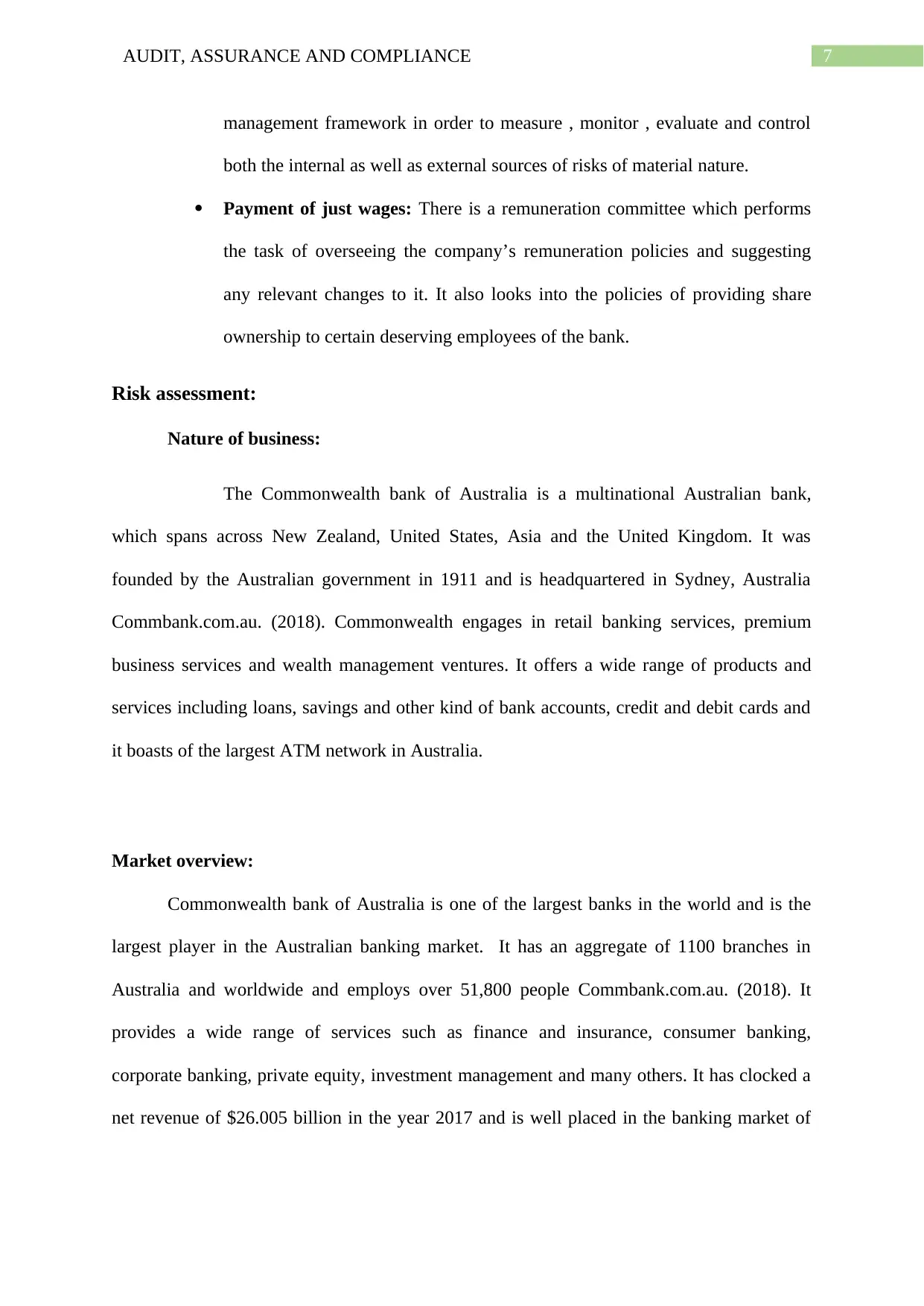
7AUDIT, ASSURANCE AND COMPLIANCE
management framework in order to measure , monitor , evaluate and control
both the internal as well as external sources of risks of material nature.
Payment of just wages: There is a remuneration committee which performs
the task of overseeing the company’s remuneration policies and suggesting
any relevant changes to it. It also looks into the policies of providing share
ownership to certain deserving employees of the bank.
Risk assessment:
Nature of business:
The Commonwealth bank of Australia is a multinational Australian bank,
which spans across New Zealand, United States, Asia and the United Kingdom. It was
founded by the Australian government in 1911 and is headquartered in Sydney, Australia
Commbank.com.au. (2018). Commonwealth engages in retail banking services, premium
business services and wealth management ventures. It offers a wide range of products and
services including loans, savings and other kind of bank accounts, credit and debit cards and
it boasts of the largest ATM network in Australia.
Market overview:
Commonwealth bank of Australia is one of the largest banks in the world and is the
largest player in the Australian banking market. It has an aggregate of 1100 branches in
Australia and worldwide and employs over 51,800 people Commbank.com.au. (2018). It
provides a wide range of services such as finance and insurance, consumer banking,
corporate banking, private equity, investment management and many others. It has clocked a
net revenue of $26.005 billion in the year 2017 and is well placed in the banking market of
management framework in order to measure , monitor , evaluate and control
both the internal as well as external sources of risks of material nature.
Payment of just wages: There is a remuneration committee which performs
the task of overseeing the company’s remuneration policies and suggesting
any relevant changes to it. It also looks into the policies of providing share
ownership to certain deserving employees of the bank.
Risk assessment:
Nature of business:
The Commonwealth bank of Australia is a multinational Australian bank,
which spans across New Zealand, United States, Asia and the United Kingdom. It was
founded by the Australian government in 1911 and is headquartered in Sydney, Australia
Commbank.com.au. (2018). Commonwealth engages in retail banking services, premium
business services and wealth management ventures. It offers a wide range of products and
services including loans, savings and other kind of bank accounts, credit and debit cards and
it boasts of the largest ATM network in Australia.
Market overview:
Commonwealth bank of Australia is one of the largest banks in the world and is the
largest player in the Australian banking market. It has an aggregate of 1100 branches in
Australia and worldwide and employs over 51,800 people Commbank.com.au. (2018). It
provides a wide range of services such as finance and insurance, consumer banking,
corporate banking, private equity, investment management and many others. It has clocked a
net revenue of $26.005 billion in the year 2017 and is well placed in the banking market of
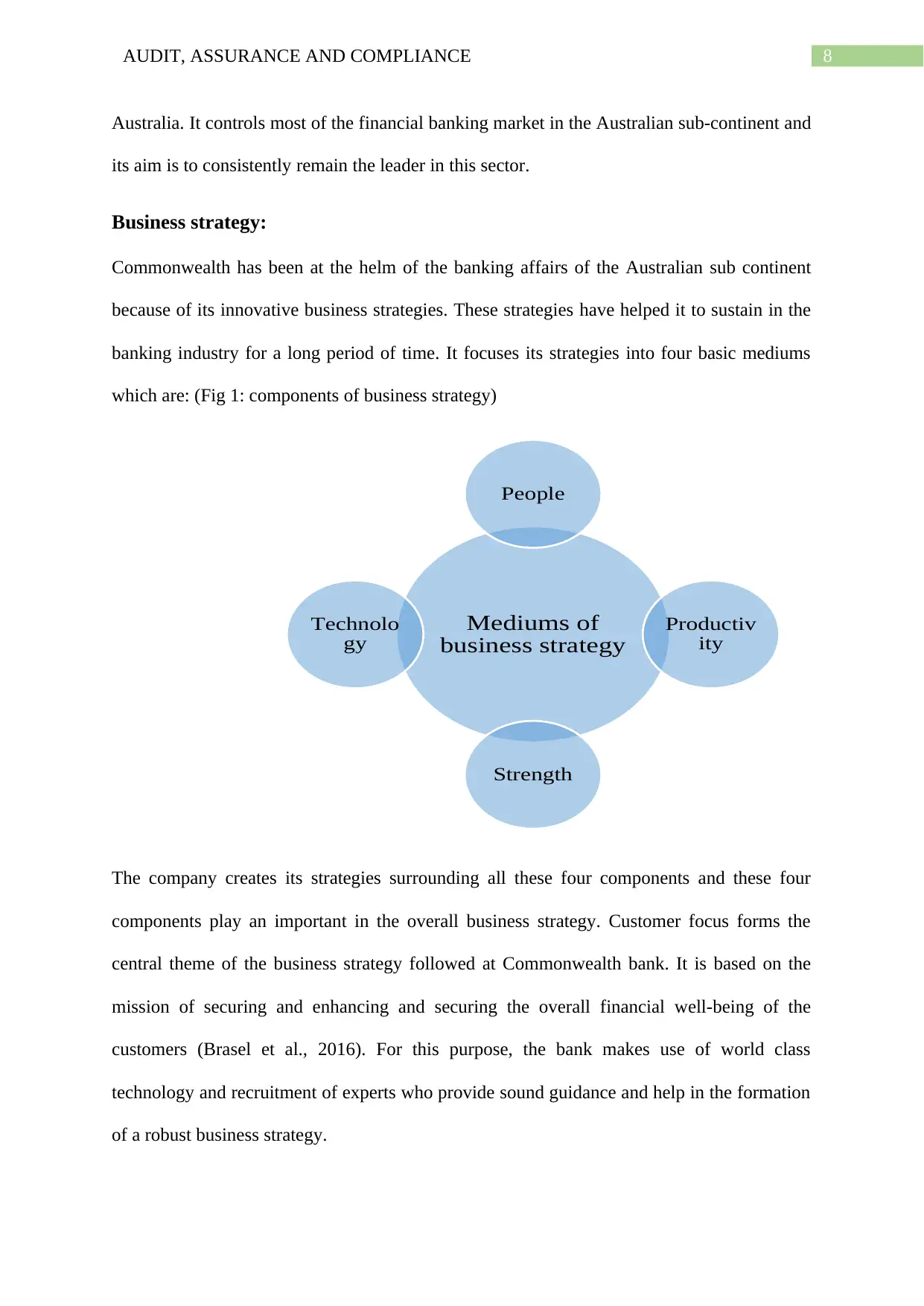
8AUDIT, ASSURANCE AND COMPLIANCE
Australia. It controls most of the financial banking market in the Australian sub-continent and
its aim is to consistently remain the leader in this sector.
Business strategy:
Commonwealth has been at the helm of the banking affairs of the Australian sub continent
because of its innovative business strategies. These strategies have helped it to sustain in the
banking industry for a long period of time. It focuses its strategies into four basic mediums
which are: (Fig 1: components of business strategy)
The company creates its strategies surrounding all these four components and these four
components play an important in the overall business strategy. Customer focus forms the
central theme of the business strategy followed at Commonwealth bank. It is based on the
mission of securing and enhancing and securing the overall financial well-being of the
customers (Brasel et al., 2016). For this purpose, the bank makes use of world class
technology and recruitment of experts who provide sound guidance and help in the formation
of a robust business strategy.
Mediums of
business strategy
People
Productiv
ity
Strength
Technolo
gy
Australia. It controls most of the financial banking market in the Australian sub-continent and
its aim is to consistently remain the leader in this sector.
Business strategy:
Commonwealth has been at the helm of the banking affairs of the Australian sub continent
because of its innovative business strategies. These strategies have helped it to sustain in the
banking industry for a long period of time. It focuses its strategies into four basic mediums
which are: (Fig 1: components of business strategy)
The company creates its strategies surrounding all these four components and these four
components play an important in the overall business strategy. Customer focus forms the
central theme of the business strategy followed at Commonwealth bank. It is based on the
mission of securing and enhancing and securing the overall financial well-being of the
customers (Brasel et al., 2016). For this purpose, the bank makes use of world class
technology and recruitment of experts who provide sound guidance and help in the formation
of a robust business strategy.
Mediums of
business strategy
People
Productiv
ity
Strength
Technolo
gy
⊘ This is a preview!⊘
Do you want full access?
Subscribe today to unlock all pages.

Trusted by 1+ million students worldwide
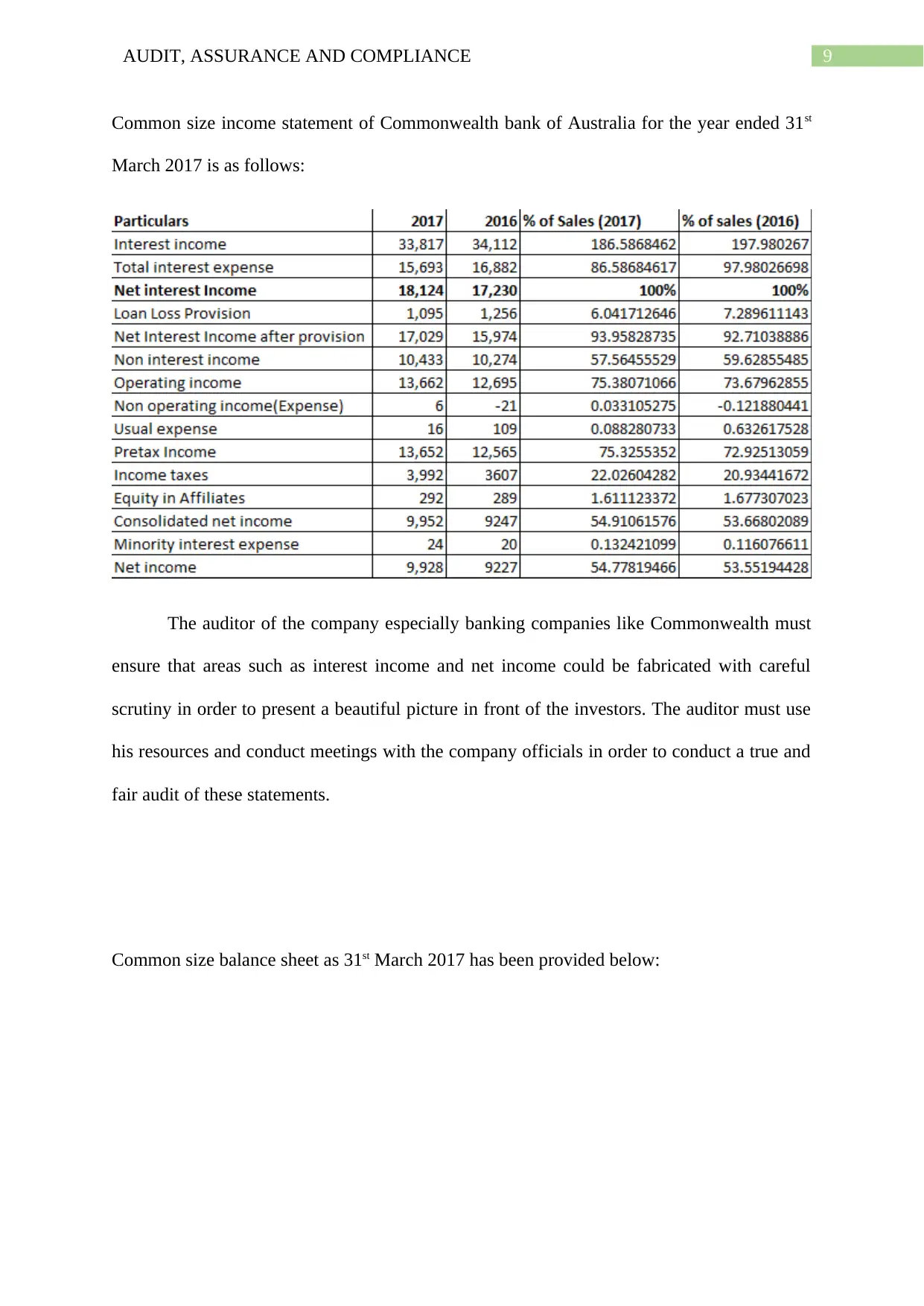
9AUDIT, ASSURANCE AND COMPLIANCE
Common size income statement of Commonwealth bank of Australia for the year ended 31st
March 2017 is as follows:
The auditor of the company especially banking companies like Commonwealth must
ensure that areas such as interest income and net income could be fabricated with careful
scrutiny in order to present a beautiful picture in front of the investors. The auditor must use
his resources and conduct meetings with the company officials in order to conduct a true and
fair audit of these statements.
Common size balance sheet as 31st March 2017 has been provided below:
Common size income statement of Commonwealth bank of Australia for the year ended 31st
March 2017 is as follows:
The auditor of the company especially banking companies like Commonwealth must
ensure that areas such as interest income and net income could be fabricated with careful
scrutiny in order to present a beautiful picture in front of the investors. The auditor must use
his resources and conduct meetings with the company officials in order to conduct a true and
fair audit of these statements.
Common size balance sheet as 31st March 2017 has been provided below:
Paraphrase This Document
Need a fresh take? Get an instant paraphrase of this document with our AI Paraphraser
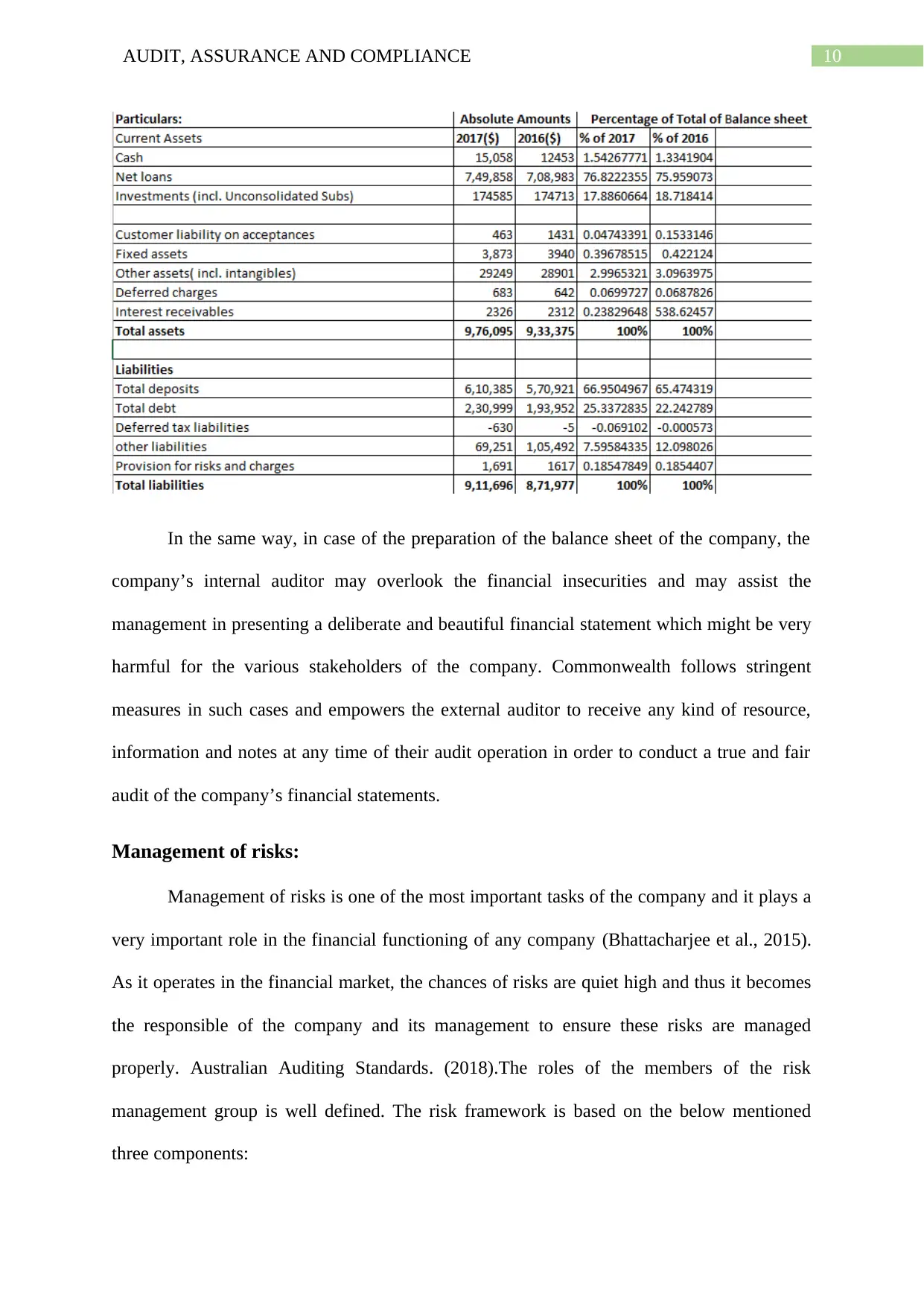
10AUDIT, ASSURANCE AND COMPLIANCE
In the same way, in case of the preparation of the balance sheet of the company, the
company’s internal auditor may overlook the financial insecurities and may assist the
management in presenting a deliberate and beautiful financial statement which might be very
harmful for the various stakeholders of the company. Commonwealth follows stringent
measures in such cases and empowers the external auditor to receive any kind of resource,
information and notes at any time of their audit operation in order to conduct a true and fair
audit of the company’s financial statements.
Management of risks:
Management of risks is one of the most important tasks of the company and it plays a
very important role in the financial functioning of any company (Bhattacharjee et al., 2015).
As it operates in the financial market, the chances of risks are quiet high and thus it becomes
the responsible of the company and its management to ensure these risks are managed
properly. Australian Auditing Standards. (2018).The roles of the members of the risk
management group is well defined. The risk framework is based on the below mentioned
three components:
In the same way, in case of the preparation of the balance sheet of the company, the
company’s internal auditor may overlook the financial insecurities and may assist the
management in presenting a deliberate and beautiful financial statement which might be very
harmful for the various stakeholders of the company. Commonwealth follows stringent
measures in such cases and empowers the external auditor to receive any kind of resource,
information and notes at any time of their audit operation in order to conduct a true and fair
audit of the company’s financial statements.
Management of risks:
Management of risks is one of the most important tasks of the company and it plays a
very important role in the financial functioning of any company (Bhattacharjee et al., 2015).
As it operates in the financial market, the chances of risks are quiet high and thus it becomes
the responsible of the company and its management to ensure these risks are managed
properly. Australian Auditing Standards. (2018).The roles of the members of the risk
management group is well defined. The risk framework is based on the below mentioned
three components:
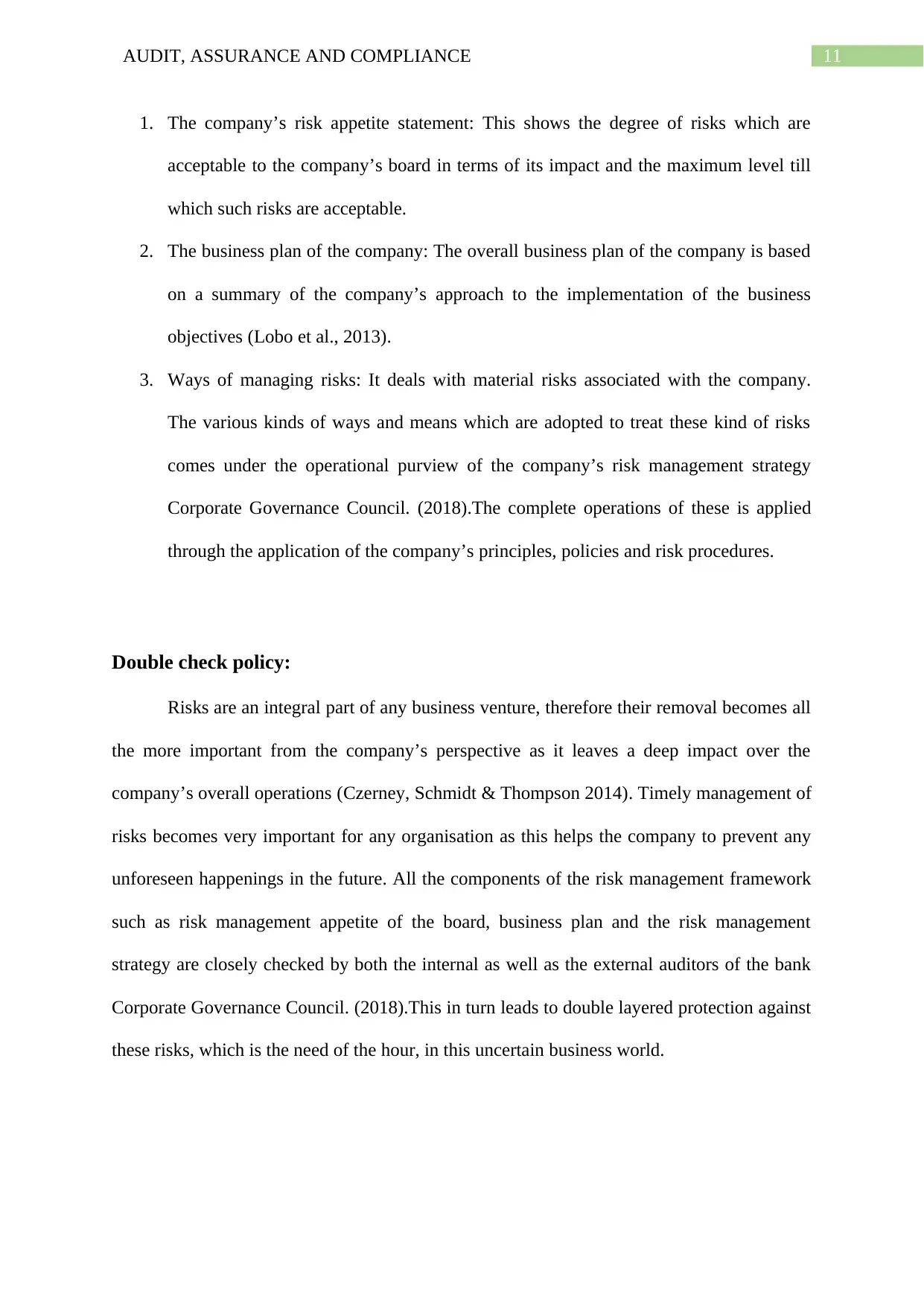
11AUDIT, ASSURANCE AND COMPLIANCE
1. The company’s risk appetite statement: This shows the degree of risks which are
acceptable to the company’s board in terms of its impact and the maximum level till
which such risks are acceptable.
2. The business plan of the company: The overall business plan of the company is based
on a summary of the company’s approach to the implementation of the business
objectives (Lobo et al., 2013).
3. Ways of managing risks: It deals with material risks associated with the company.
The various kinds of ways and means which are adopted to treat these kind of risks
comes under the operational purview of the company’s risk management strategy
Corporate Governance Council. (2018).The complete operations of these is applied
through the application of the company’s principles, policies and risk procedures.
Double check policy:
Risks are an integral part of any business venture, therefore their removal becomes all
the more important from the company’s perspective as it leaves a deep impact over the
company’s overall operations (Czerney, Schmidt & Thompson 2014). Timely management of
risks becomes very important for any organisation as this helps the company to prevent any
unforeseen happenings in the future. All the components of the risk management framework
such as risk management appetite of the board, business plan and the risk management
strategy are closely checked by both the internal as well as the external auditors of the bank
Corporate Governance Council. (2018).This in turn leads to double layered protection against
these risks, which is the need of the hour, in this uncertain business world.
1. The company’s risk appetite statement: This shows the degree of risks which are
acceptable to the company’s board in terms of its impact and the maximum level till
which such risks are acceptable.
2. The business plan of the company: The overall business plan of the company is based
on a summary of the company’s approach to the implementation of the business
objectives (Lobo et al., 2013).
3. Ways of managing risks: It deals with material risks associated with the company.
The various kinds of ways and means which are adopted to treat these kind of risks
comes under the operational purview of the company’s risk management strategy
Corporate Governance Council. (2018).The complete operations of these is applied
through the application of the company’s principles, policies and risk procedures.
Double check policy:
Risks are an integral part of any business venture, therefore their removal becomes all
the more important from the company’s perspective as it leaves a deep impact over the
company’s overall operations (Czerney, Schmidt & Thompson 2014). Timely management of
risks becomes very important for any organisation as this helps the company to prevent any
unforeseen happenings in the future. All the components of the risk management framework
such as risk management appetite of the board, business plan and the risk management
strategy are closely checked by both the internal as well as the external auditors of the bank
Corporate Governance Council. (2018).This in turn leads to double layered protection against
these risks, which is the need of the hour, in this uncertain business world.
⊘ This is a preview!⊘
Do you want full access?
Subscribe today to unlock all pages.

Trusted by 1+ million students worldwide
1 out of 16
Related Documents
Your All-in-One AI-Powered Toolkit for Academic Success.
+13062052269
info@desklib.com
Available 24*7 on WhatsApp / Email
![[object Object]](/_next/static/media/star-bottom.7253800d.svg)
Unlock your academic potential
Copyright © 2020–2025 A2Z Services. All Rights Reserved. Developed and managed by ZUCOL.




